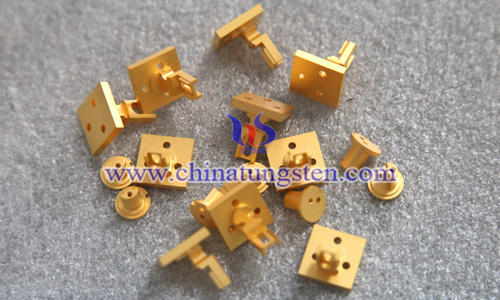Rare Earths Make Mighty Magnets
- Details
- Category: Tungsten's News
- Published on Saturday, 27 May 2023 19:30
- Hits: 817
In 1945, scientists built the ENIAC, the world's first programmable general-purpose digital computer (SN: 2/23/46, p. 118). Nicknamed the "Giant Brain," ENIAC weighed more than four elephants and covered an area about two-thirds the size of a tennis court. Less than 80 years later, the ubiquitous smartphone, which has far more computing power than the ENIAC. society owes this miniaturization of electronics in large part to the special magnetic power of rare earths. A small rare-earth magnet can do the same job as large magnets that do not contain rare earths.

(Photo source: protoolreviews.com)
It's those f-electrons at work. Rare earths have many electron orbitals, but the f-electrons reside in a specific group of seven orbitals called the 4f subshell. In any subshell, the electrons try to spread themselves out in the orbitals within it. Each orbital can hold up to two electrons. However, since the 4f subshell contains seven orbitals and most rare earths contain less than 14 f electrons, these elements tend to have multiple orbitals with only one electron. For example, neodymium atoms have four such longons, while dysprosium and samarium have five. Importantly, these unpaired electrons tend to point (or rotate) in the same direction, which is how we classically understand the formation of the magnetic north and south poles.
Because these lone f-electrons flicker behind a shell of valence electrons, their synchronized spins are somewhat shielded from demagnetizing forces such as heat and other magnetic fields, making them ideal for use in building permanent magnets. Permanent magnets, like those holding up pictures on refrigerator doors, passively generate a magnetic field from their atomic structure, unlike electromagnets, which require an electric current and can be turned off.
However, even with a shield, rare earths have limitations. Pure neodymium, for example, is susceptible to corrosion and fracture, and its magnetism begins to lose strength above 80 degrees Celsius. So manufacturers alloy some rare earths with other metals to make more resilient magnets, says Durga Paudyal, a theoretical physicist at Ames National Laboratory in Iowa: "It works well because some rare earth can coordinate the magnetic fields of other metals. Just as weighted dice fall preferentially to one side, some rare earth such as neodymium and samarium exhibit stronger magnetism in certain directions because their 4f subshells contain unevenly filled orbitals. This directionality is known as magnetic anisotropy and can be used to coordinate the magnetic fields of other metals such as iron or cobalt to form strong, extremely powerful magnets."

(Photo source: protoolreviews.com)
The most powerful rare earth alloy magnets are neodymium magnets. For example, a three-kilogram neodymium magnet can lift an object weighing more than 300 kilograms. More than 95% of the world's permanent magnets are made of this rare-earth alloy. Neodymium magnets produce vibrations in smartphones, sound in earbuds and headphones, read and write data in hard drives, and generate the magnetic fields used in MRI machines. Adding a little dysprosium to these magnets improves the heat resistance of the alloy, making it a good choice for rotors that spin inside the high temperatures of many electric vehicle engines.
Developed in the 1960s, samarium cobalt magnets were the first popular rare earth magnets. Although slightly weaker than NdFeB magnets, samarium cobalt magnets have excellent heat and corrosion resistance, so they are used in high-speed motors, generators, speed sensors in cars and airplanes, and in the moving parts of some heat-seeking missiles. Samarium cobalt magnets also form the core of most traveling wave tubes, which enhance signals from radar systems and communications satellites. Some of these tubes are transmitting data from the Voyager 1 spacecraft - currently the most distant man-made object - more than 23 billion kilometers away (SN: 7/31/21, p. 18).
Rare earth magnets are supporting green technology because of their strength and reliability. They are found in electric vehicles' motors, drivetrains, power steering systems and many other components. Tesla's use of neodymium-magnets in its longest-range Model 3 car has raised concerns about the supply chain; China supplies the vast majority of the world's neodymium (SN: 1/11/23).
In August, Chinese engineers unveiled "Rainbow," the world's first magnetically levitated train line based on rare-earth magnets, which allows trains to float without consuming electricity.
In the future, rare earth may even drive quantum computing. While conventional computers use binary bits, quantum computers use quantum bits, which can occupy both states. Crystals containing rare earths have proven to be good quantum bits because shielded f-electrons can store quantum information for a long time, and researchers predict that one day, computer scientists may even use the luminescent properties of rare earth in quantum bits to share information among quantum computers, giving birth to a quantum Internet.
Reference: https://www.sciencenews.org/article/rare-earth-elements-properties-technology
- Rare Earth Manufacturer & Supplier, Chinatungsten Online: www.chinatungsten.com
- Tungsten News & Prices of China Tungsten Industry Association: www.ctia.com.cn
- Molybdenum News & Price: news.molybdenum.com.cn
- Tel.: 86 592 5129696; Fax: 86 592 5129797; Email: sales@chinatungsten.com








 sales@chinatungsten.com
sales@chinatungsten.com